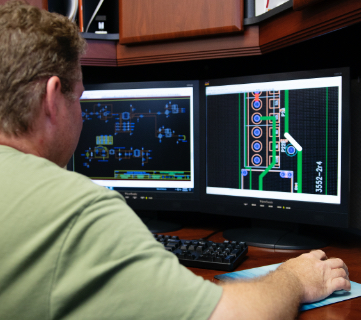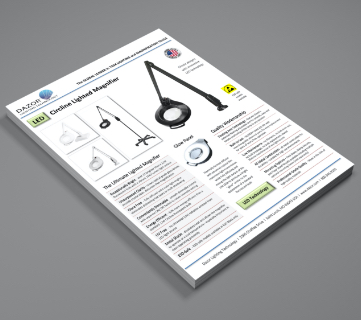How to Choose a Lighted Magnifier
A lighted magnifier, or illuminated magnifier, is an essential tool for anyone involved in precision assembly or design, but it is also an excellent aid for people who have trouble with their vision. Lighted magnifiers reduce eye strain and fatigue while allowing the user to see the small details of the object being viewed.
Choosing the best magnifying lamp for your application requires some study as to how these products function.
What diopter lens should you choose?
Diopter refers to the curvature of a lens. As the diopter increases, the lens becomes thicker and the curvature greater. As the curvature increases, light rays are redirected to fill a greater portion of the viewer's retina, which makes the object look bigger. As seen in the chart below, the higher the diopter, the more magnification the lens provides.
| Model Series | Diopter | Power | % Bigger than Object | Focal Length | Viewing Area |
|---|---|---|---|---|---|
| Circline | 3 | 1.75X | 75% | 13" | 5-inch circle |
| 5 | 2.25X | 125% | 8" | 5-inch circle | |
| 11 | 3.75X | 275% | 3.75" | 3-inch circle | |
| 16 | 5.00X | 400% | 2.5" | 3-inch circle | |
| Hi-Lighting | 3 | 1.75X | 75% | 13" | 5-inch circle |
| 5 | 2.25X | 125% | 8" | 5-inch circle | |
| StretchView | 3 | 1.75X | 75% | 13" | 4.5" x 6.75" |
| 5 | 2.25X | 125% | 8" | 3" x 5" | |
| 16 | 5.00X | 400% | 2.5" | 3-inch circle |
How do diopters translate to power?
Power refers to how much larger an object is made to look through a magnifying lens. Power is typically indicated by an "X" such as 2X or 4X. The relationship between diopters and power is: diopters divided by 4 + 1 (original object) equal power. For example, a 16 diopter lens would be (16 diopters ÷ 4 + 1 = 5X power).
Why is focal length important?
Focal length is the distance from the center of a lens to the point where the light rays converge and the object is in optimal focus (focal point). This is also known as the "working distance" of the lens. Focal length is important when the task requires using tools with the object being viewed. Because focal length decreases as power increases, there is less room to perform work on an object under higher power lenses.
How big will the field of view be?
The field of view is the size of the magnified area under the lens that is in focus. The field of view decreases as power increases. More powerful lenses make small details look big, but less of the total object is visible. There is a trade-off for the viewer who must decide between the size of the field of view and amount of magnification.
| Magnification Chart | |||
|---|---|---|---|
| % Magnification | Diopter | Focal Length | Sample View |
| Normal Newsprint | 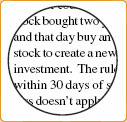 |
||
| +75% magnification | 3-diopter lens | Focal length of 13" | 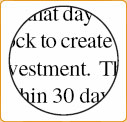 |
| +125% magnification | 5-diopter lens | Focal length of 8" | 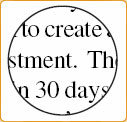 |
| +275% magnification | 11-diopters (3-diopter lens plus ADD-A-LENS) | Focal length of 3.75" | 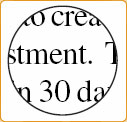 |
| +400% magnification | 16-diopter lens system | Focal length of 2.5" | 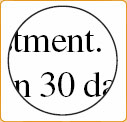 |
Why do I want a "lighted" magnifier?
Proper lighting is equally important as magnification in achieving a good viewing situation. A magnifying lens would be useless in the dark, so increasing light levels result in better vision. In fact, the better the quality of light used with a magnifying lens, the less power is needed. When less magnification is required, the user has a bigger field of view and working distance under the lens. Therefore, the quality of light should be closely evaluated when choosing an illuminated magnifying lamp.
Why is "HANDS-FREE" viewing easier?
It is much easier to have both hands free to grasp an object and not worry about holding a magnifier or light. When using an illuminated magnifier mounted on an adjustable-arm, you are able to hold a fully spread newspaper with both hands. If your task requires working with both hands (such as cross-stitch or fly-tying), having a hands-free magnifier is essential. Dazor magnifiers are mounted on an adjustable-arm for hands-free viewing.
What is the price of an illuminated magnifier?
The price varies depending upon the type of light, magnification, and mounting options. The most popular models and options cost about the same as a good pair of prescription eye glasses.


